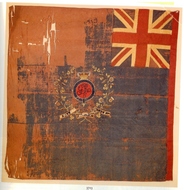U.K. 5th Royal Veteran's Reserve Regiment circa 1812, deaccessed from the Smithsonian.
This post 1801 British Infantry Color can be distinguished from its predecessors by the diagonal, so-called St. Patrick's red counter-changed cross in the canton. Used between 1802 and 1819, this un-faded, embroidered, silk color was carried by the 5th Royal Veteran Battalion
The British Army, like many of its European counterparts, formed Invalid and later Veteran Battalions. These were separate battalions manned with veteran volunteers who had been previously discharged from regular service on account of wounds, age or illness.
Contrary to what the "invalid" title may convey, these were well-trained veterans and subsequently were a respectable force. An "invalid" was simply a pensioner, whether disabled or not. Being of limited physical capability, the veterans had only light duties in a home defense role.
These battalions were fashioned by recruiting or transferring veterans into garrison forts, which allowed other soldiers to perform strenuous field duty. Battalions of generally six companies were formed of pensioners; those accepted were less than fifty-five years of age and had served less than twenty-four years in the cavalry or twenty-one years in the infantry. These individuals had been discharged as privates and were willing to reenlist.
During the Napoleonic Wars (1803 to 1815) these troops were called Veterans Battalions and were composed of low, medical-grade troops who were generally given independent garrison duties and were ideal for Channel Islands service.
In 1802, the 5th Royal Garrison Battalion raised in Guernsey, Channel Islands, and was re-formed and disbanded several times. The most noted reformation of the Battalion was their last re-formation in 1819 at Shrewsbury. The group was charged to station in case they were needed to quell domestic unrest following the "Peterloo Massacre."
The Peterloo Massacre of August 16, 1819 was a charge into a meeting of the Manchester Patriotic Union Society being held for impoverished workers and their families, at St Peter's Fields, Manchester, England. The meeting's organizers also called for parliamentary reform and the repeal of the Corn Laws, import tariffs designed to support the market for British corn.
After the event, the government supported the action of the army and several of the Royal Veterans Battalions were re-formed, including the 5th Royal Veteran Battalion. They were disbanded for the final time in 1821 at Shrewsbury.
This color of 5th Royal Veteran Battalion was formerly part of the Smithsonian Institution's collection. This flag was part of the large militaria collection bequeathed in 1979 by Charles Bremner Hogg Jackson to the Smithsonian Institution, Washington DC. In 1996 The Smithsonian de-accessed many of its non-American relics. This flag was part of that group.
It is a rare and exceptional color and may be the only such Napoleonic Wars color in the United States.
ZFC Significant Flag
Item is Framed
Provenance:
• 5th Royal Veteran Battalion, 1802 - 1821.
• By descent.
• Acquired by The Charles Brenner Hogg Jackson Collection, until 1979.
• By bequest to the Smithsonian Institution, Washington, DC until deaccessed 1995.
• Sold via Butterfield & Butterfield Auctions, SF, CA, to the Zaricor Flag Collection, 1996.
Sources:
Fosten, Bryan, Wellington's Infantry, Osprey Publishing, Oxford, 1982, p.20.
Sumner, Ina, British Colors & standards 1747-1881, (2), Osprey Publishing, Oxford, 2001.
The Charles Bremner Hogg Jackson Collection: bequest to The Smithsonian Institution's National Museum of American History, Butterfield & Butterfield Auction, San Francisco, 1996, p. 207.
United Kingdom: Royal Reserve Battalions, Flags of the World, 25 October 2011, from: http://www.crwflags.com/fotw/flags/gb%5Errb.html
Royal Garrison Battalions - Napoleonic era, Ancestry.com, 25 October 2011, from: http://boards.ancestry.co.uk/topics.Military.uk.britarmy/2024.1/mb.ashx
Peterloo Massacre, Wikipedia, 25 October 2011, from: http://en.wikipedia.org/wiki/Peterloo_Massacre
Image Credits:
Zaricor Flag Collection
RTZFC



































